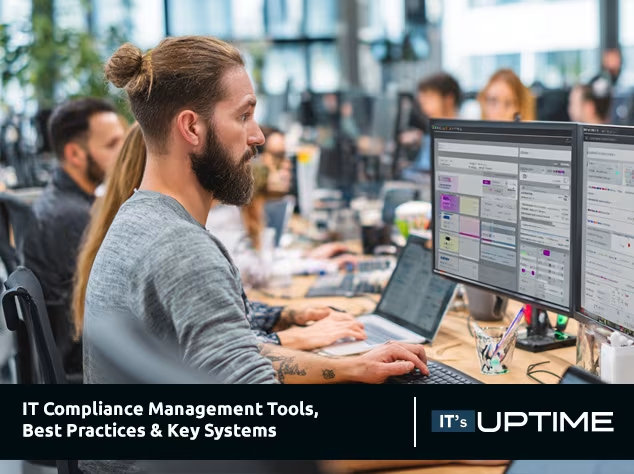Ensure Business Continuity With Powerful Management Software
George Grubor


Uncertainty is no longer the exception—it’s the norm. Whether it's a cyberattack, natural disaster, or a critical supply chain disruption, the ability to withstand and recover from unexpected events defines long-term business success. That’s where business continuity comes in.
Organizations that prioritize operational resilience and adopt the right business continuity management software are best equipped to weather disruptions, maintain critical business functions, and recover quickly. In this guide, we explore how effective business continuity planning—powered by the right software solution—helps protect your enterprise, meet regulatory requirements, and reduce risk in today’s volatile world.
Why should you enable business continuity for your business?
A robust business continuity strategy is more than a risk management checkbox. It’s the lifeline of your operations. From financial services to manufacturing and healthcare, every industry faces potential crises that could halt productivity or jeopardize stakeholder trust.
By implementing a strong business continuity plan, you can:
- Mitigate disruptions before they escalate
- Ensure continuity of operations during a crisis
- Protect critical business functions and data
- Support faster recovery time and reduce downtime
- Comply with regulatory and security requirements

Preparedness starts with visibility—understanding which business functions are essential and what it takes to keep them running. This is where business impact analyses and risk assessment tools come into play.
How business continuity management software empowers your strategy
Modern management software allows you to build, automate, and manage your continuity processes on one platform. Instead of relying on spreadsheets or disconnected documentation, business continuity software centralizes everything—planning, updates, communications, testing, and reporting.
Top business continuity platforms include features such as:
- Real-time crisis management dashboards
- Automated alerts and incident management
- Disaster recovery plan templates and workflows
- Integrated business impact analysis
- Data protection and backup functionality
- Stakeholder communications tools
A trusted business continuity program doesn't just sit on a shelf—it evolves with your operations. Software helps ensure your continuity strategies remain aligned with changing business needs, regulatory standards, and emerging threats.

What makes a successful business continuity plan?
An effective business continuity plan (BCP) outlines how your organization will continue critical business operations during and after a disruption. It identifies vulnerabilities, prioritizes essential services, and establishes recovery strategies across departments.
Key elements include:
- Business impact analysis: Assess the consequences of downtime
- Risk assessment: Identify and rank potential threats
- Recovery strategies: Define clear response and recovery actions
- Plan development: Create and document response protocols
- Testing and training: Conduct regular simulations and stakeholder education
- Incident management: Ensure rapid and coordinated responses
Successful planning solutions are tailored to the organization. With customizable business continuity planning software, companies can adapt templates, timelines, and communication tools to fit their unique structure and industry requirements.

Why operational resilience is a competitive advantage
Operational resilience is more than survival—it’s adaptability. Companies that recover quickly from disruption often gain an edge in their industry. Whether responding to a cyberattack or managing pandemic-related shutdowns, resilient businesses avoid costly downtime, safeguard their brand, and continue serving customers.
Resilience also inspires confidence. Investors, partners, and customers expect organizations to have clear continuity plans in place. Demonstrating your ability to handle disruption positions your business as a trusted leader in its space.
How to choose the right business continuity software solution
Choosing the best business continuity software depends on your company’s size, complexity, and industry. However, some common capabilities set the best business continuity platforms apart:
- Integration with other management tools (ITSM, compliance software, risk platforms)
- Scalability for enterprise-level operations
- Role-based access control for secure collaboration
- Automated reporting and audit readiness
- Real-time data analytics and alerts
- Support for both disaster recovery and business continuity planning
Solutions like the Fusion Framework System provide customizable, enterprise-grade tools to help organizations plan for and respond to any threat. They also simplify compliance with ISO, NIST, and other regulatory frameworks.

Building a business continuity program that grows with you
A business continuity program isn’t a one-time investment. It’s an ongoing effort to align people, processes, and technology around a common goal—operational continuity.
Here’s how to keep your continuity program relevant:
- Review your business continuity strategy quarterly
- Perform regular testing and table-top exercises
- Update your business continuity plans after major changes
- Engage all departments in the planning process
- Use insights from previous incidents to strengthen your response
With the right software platform and consulting services, organizations can scale their continuity programs across regions and business units, ensuring every critical business function is protected.
Don’t wait for a disaster to strike
Waiting until a crisis hits to develop your response is a recipe for failure. Instead, take a proactive approach to business continuity. Investing in the right business continuity management software ensures that your organization can act fast, minimize impact, and protect what matters most.
By pairing technology with best practices, you’ll not only ensure business continuity but also foster a culture of resilience. And in today’s world, that may be your greatest asset.
FAQs
What is a business continuity plan, and why is it important?
A business continuity plan outlines how a company will maintain operations during an unexpected disruption, such as a natural disaster or cyberattack. It ensures business resilience, minimizes downtime, and helps protect critical business functions.
How does business continuity software help during a crisis?
Business continuity software centralizes planning, response, and recovery strategies. It provides real-time visibility, automates incident management, and supports coordination across departments to respond effectively during a disruption.
What’s the difference between disaster recovery and business continuity?
Disaster recovery focuses on restoring IT systems and data, while business continuity addresses the broader goal of maintaining business operations during and after a crisis. Both are essential parts of a comprehensive resilience strategy.
How often should I update my business continuity plan?
You should review and update your business continuity plan at least once a year or after major business changes, such as new technology, office relocations, or changes in leadership. Regular testing and training also ensure readiness.









